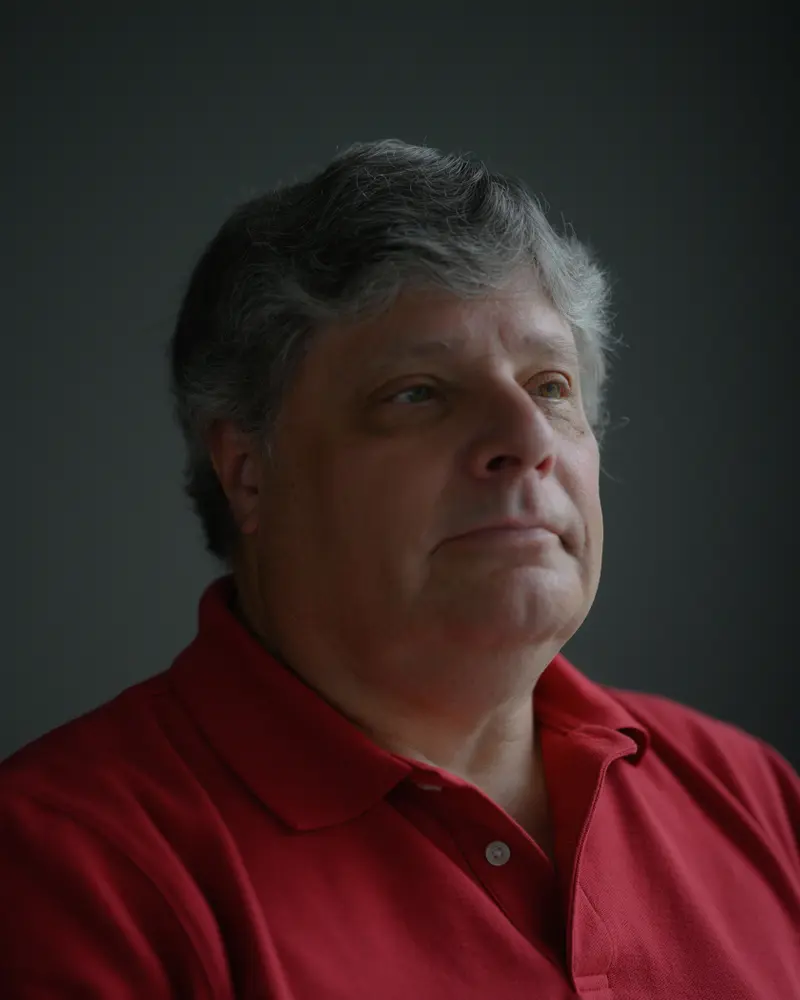Theresa Opalinski was warming up her border collies for their agility training one day in 2011 when she couldn’t catch her breath. Her husband, Michael, suggested they go to urgent care, and a few days later, a specialist drained more than a liter of fluid from her left lung. After ping-ponging between local hospitals, she underwent an exploratory surgery, which confirmed she had mesothelioma.
The diagnosis puzzled them. Asbestos exposure is the only known cause of the vicious cancer, which kills most people who get it within a few years. Because cases often involve occupational exposure in industries like shipbuilding and construction — and because it can take decades for the cancer to develop — mesothelioma is sometimes thought of as an old man’s disease. Theresa was just 53 and held a master’s in public administration. She had been a congressional aide, she’d managed a nonprofit, she’d worked in marketing. Never with asbestos.
Far from her mind was the fact that she and Michael had grown up a mile away from a plant in North Tonawanda, New York, that used a type of asbestos that is blue in color to make industrial plastics. The plant’s owner, OxyChem, closed and demolished the facility in the 1990s. But the company has since faced at least 10 lawsuits alleging that the plant released so much asbestos into the environment that residents of the surrounding neighborhood developed mesothelioma and other ailments associated with the toxic substance.
The blue dust settled onto windowsills and on a Little League field and atop fresh snow, lawsuits allege and residents recall. It got stuck in workers’ hair and on their clothes and wound up on the seats of their cars and inside their homes. One woman, married to a plant employee, died after years of washing her husband’s asbestos-soiled uniform, her family said.
OxyChem declined to comment on the lawsuits involving its plastics plant. Most of the cases have been settled out of court, records show. Two are pending. In some of the cases, OxyChem said it was not responsible for the plaintiff’s injuries. In at least one, the company said the lawsuit had not been filed by the legally required deadline.
The latest suits, filed earlier this year, come as the company is forced to reckon with its other uses of asbestos — and contemplate a future without it. Unlike some 60 other countries, the United States hasn’t banned asbestos. OxyChem is one of two chemical companies that import and use the potent carcinogen to make chlorine. For decades, it has maintained that the workers in its chlorine plants face no threat of exposure; in recent months, it has used that argument to fight a proposed federal ban on the substance.
But last week, ProPublica reported that asbestos accumulated in a number of areas inside and around OxyChem’s chlorine plant in Niagara Falls, New York, and that employees worked amid the dust until the plant closed late last year. They often went without protective suits or masks in the building where asbestos was removed from equipment, they said. “We were constantly swimming in this stuff,” one former employee said.
Though the two OxyChem plants that have come under scrutiny used different types of asbestos for different industrial processes, there are striking similarities between the facilities, which are 10 miles apart. Experts say both situations speak to OxyChem’s poor track record of containing asbestos in its plants, and they both illustrate the carcinogen’s long tail and broad impact.
Asbestos is a naturally occurring mineral known for its strength, durability and ability to resist heat. It was once used widely in industrial operations and construction. But its tiny fibers can also do serious damage. Once inhaled, they can settle into the lungs, abdomen and other parts of the body, where they can cause cancer and other deadly conditions.
The North Tonawanda plant was built in the 1920s, state Department of Environmental Conservation records show. It was acquired by Hooker Chemical in the 1950s, then by Occidental Petroleum, OxyChem’s parent company, in the 1960s.
The asbestos used at the plant sickened workers, some of whom went on to sue the asbestos companies that sold the material, court records and news clips show. The asbestos use also had a profound effect on the surrounding community, the lawsuits against OxyChem allege. When the plant got too dusty, the workers used air hoses to remove fibers from the facility, according to the lawsuits.
One of the plaintiffs, James Urban, played baseball on a Little League field that was regularly contaminated by dust from the plant in the late 1960s, according to his lawsuit. Nearly 30 years later, doctors found fluid between the layers of tissue lining his lungs, a condition known as a pleural effusion that can be caused by asbestos exposure. Urban declined to comment when reached at home by ProPublica.
Michael Opalinski used to clean a fine blue dust off the windowsills of his home when he was growing up in North Tonawanda in the 1960s and ’70s, he told ProPublica. He sometimes saw tiny blue feathers atop a fresh snowfall. He recalled at least two explosions at the plant that expelled clouds of dust into the air.
Paul Richards worked at the plant from 1962 to 1980, he said. One of his jobs was to empty 100-pound bags of asbestos and stomp the material through a grate in the floor. After a shift, asbestos would cover his face, he said. It would slip underneath his collar and inside his pockets.

At home, Paul’s wife, Jean, would take his dirty uniforms into the basement, shake them out and launder them. Then one day, more than a decade after Paul had left the plant, Jean was diagnosed with lung cancer. “That’s how she got sick,” he said recently. “Just from washing my clothes.” Jean battled the cancer for years, her daughter, Amy Shuler, said, undergoing chemotherapy and other treatments, often feeling too sick to eat or drink.
When Jean died in 2005 at age 62, Paul lost his high school sweetheart and longtime hunting and fishing partner. Amy lost the mother who doted on her and took her shopping and then out to lunch each Saturday. “I lost my best friend, all because my dad had worked with asbestos and mom would breathe in the dust when she would shake his clothing out before putting it in the wash,” Amy said. “No one told us of the dangers.”
For Theresa Opalinski, treatment was grueling: a surgery to remove part of the lining of her lungs, four rounds of chemotherapy. She lost weight, grew weak. The disease, Michael said, was like “putting on a cement overcoat.” “It forms a hard shell [around the lungs], to the point where you can’t breathe.” Later, Theresa participated in phase 1 trials of experimental therapies at the National Institutes of Health in Bethesda, Maryland. She pushed through them not because she expected to beat the cancer herself, but so that one day, someone else might, her husband said. She died in 2016 at age 58.

Michael, who had seen a local law firm’s billboard seeking North Tonawanda residents diagnosed with mesothelioma, didn’t call until after Theresa died, he said. He told ProPublica he couldn’t say much about the lawsuit he filed against OxyChem in 2017. Records show it was settled out of court.
The Opalinskis had plans to retire early, travel the world, take the dogs to national agility competitions. Everything is different now. In 2020, he left the city where he and Theresa grew up and moved to the countryside. His new house has a big yard for the dogs. He wishes Theresa had lived to see it. He thinks about her when he’s on the back porch, listening to the wind blow through the leaves. She loved being outside, especially in the summer. “It’s tough that you can’t share it with her,” he said.
He still struggles to make sense of it: the diagnosis, her loss, how it could have happened in the first place. Even in the 1960s when Theresa was likely exposed, asbestos was a known carcinogen. “If what you are producing is very harmful and you’ve known it since the 1950s,” he asked, “why would you do it?”


















